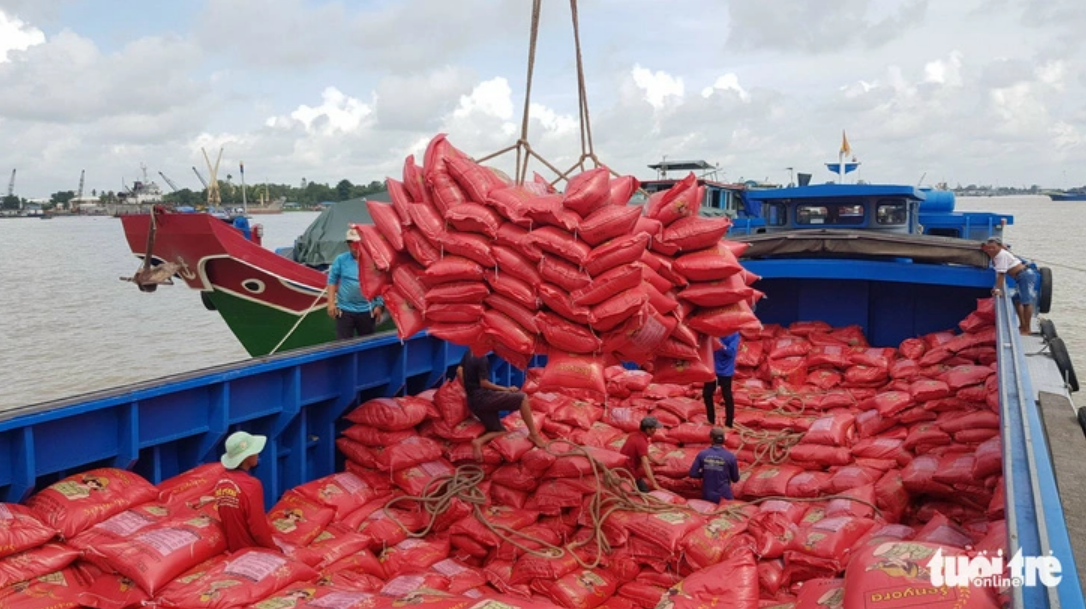VIETNAM SEES MORE OPPORTUNE TO BEEF UP SHIPMENT AFTER INDIA IMPOSES BAN ON RICE EXPORT
The Indian government is weighing a ban on the export of many rice types to control inflation, creating a good chance for Vietnam to accelerate outbound sales of rice, said several industry insiders.

Many rice firms have proposed banks offer preferential loan packages so that they can invest in warehouses and rice drying systems. Photo: Buu Dau / Tuoi Tre
Many local rice exporters can benefit from the opportunity for long if Vietnam diversifies its rice import markets.
Pham Thai Binh, general director of Trung An Hi-Tech Farming JSC in the Mekong Delta city of Can Tho, said that the price of exported rice quoted by the firm has soared 20 percent year on year.
The hike was attributed to the global food shortage and falling rice cultivation area in many nations, he said.
In addition, the arrival of the natural climate phenomenon El Niño has affected rice crops, pushing up the global rice price to a two-year high.
“India is considering a ban on rice exports, taking a heavy toll on the global rice supply, while the price of Thai rice has surged due to a rebound in Thai baht, opening a wider door for Vietnam to ramp up rice exports,” Binh said.
In 2022, India, the world’s biggest rice exporter, banned the export of broken rice and slapped a 20-percent export tax on several rice varieties.
Meanwhile, Vietnam saw the yield in this year’s winter-spring rice crop climb, coupled with higher rice prices, giving the good fortune to local rice exporters.
“India’s plan to ban rice exports will make Vietnam and Thailand more opportune to raise prices,” said Nguyen Duy Thuan, general director of Loc Troi Group, a local rice supplier.
If Vietnam seizes the opportunity to ramp up rice exports, international consumers might recognize the country as a reliable and stable rice supplier, he underscored.
To make the most of the opportunity, Vietnam should improve the quality of rice and origin traceability, and attach much significance to rice growing processes toward sustainable production, according to the leader of Loc Troi Group.
Local rice exporters should enter long-term purchase contracts with their foreign partners to stabilize consumption and reassure rice farmers, as well as increase investment in warehouses and equipment of rice production and processing.
These attempts and changes will help Vietnam cement its position in the global food market, Thuan said.
 Workers load bags of rice onto a ship for export in Vietnam. Photo: Buu Dau / Tuoi Tre
Workers load bags of rice onto a ship for export in Vietnam. Photo: Buu Dau / Tuoi Tre
Le Hoang Dai Trang, chairwoman of rice exporting firm Gavi, said that Vietnam exported 7.1 million metric tons of rice in 2022.
The volume of Vietnamese rice exports in 2023 is expected to be much higher than the 2022 figure thanks to India’s upcoming changes in rice supply.
“Gavi is exporting white rice to its traditional markets, and is planning to expand its sale of high-quality fragrant rice to selective markets such as Europe, the United States, and Australia," Trang said.
“The company is partnering with other firms to increase exported rice prices amid soaring demand."
Do Ha Nam, vice-chairman of the Vietnam Food Association, said that India is selling its rice to 150 nations and territories.
Its restrictions on rice exports will make life easier for Vietnamese exporters to expand their reach.
Vietnam’s outbound shipments of rice totaled 4.27 million metric tons worth US$2.3 billion in the first half of 2023, up 22.2 percent in volume and 34.7 percent in value from the year-ago period, according to the Ministry of Agriculture and Rural Development.
The country’s average rice export price stood at $539 a tonne during the period, up 10.2 percent year on year.
The United States Department of Agriculture forecast that Vietnam’s rice exports will amount to over seven million metric tons this year due to rising rice demands of many Asian nations.
As such, Vietnam is predicted to come third for global rice exports this year, after India and Thailand, accounting for 12.7 percent of the world’s total rice trading.
Speaking of the rice sector, an official of the People’s Committee of An Giang Province in the Mekong Delta region said that the province will focus on producing rice with enhanced efforts in reducing emissions, replacing foreign fertilizers with made-in-Vietnam ones, and advancing rice quality to elevate farmers’ income, protect the environment, and develop a sustainable rice industry.
Source: tuoitre.vn